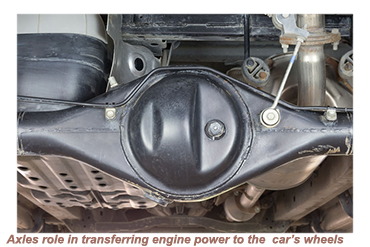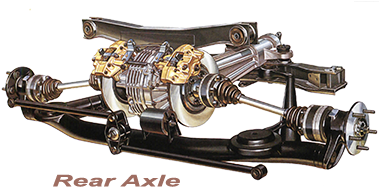
Maintaining a classic car's axle is an important part of keeping the vehicle in maximum running condition.
The engine of the vehicle generates torque that is transmitted to the axle, a rod or shaft that links the two wheels. This torque causes the wheels to rotate and move the vehicle forward. To clarify, the axle is a crucial component of a vehicle that has a two-fold function. Firstly, it connects the wheels of the car, and secondly, it transmits the power generated by the engine to propel the wheels either forward or backward.
A car typically has two axles, one in the front and one in the rear. Each axle is responsible for transmitting power from the engine to the wheels and supporting the weight of the vehicle.
In most cases, the number of axles in a vehicle is determined by the number of wheels it has, with one axle being present for every two wheels. The axle is a central shaft that connects a pair of wheels on opposite sides of a vehicle or machinery. The front axle and rear axle are two important components of a vehicle's drivetrain system. The front axle is responsible for transmitting power from the engine to the front wheels, while the rear axle transmits
The front axle and rear axle are two important components of a vehicle's drivetrain system. The front axle is responsible for transmitting power from the engine to the front wheels, while the rear axle transmits
The front and rear axles of a classic car have different configurations for their respective wheel and axle components. In most cars, the rear axle consists of a pair of interconnected half shafts. Front axles are designed to be more robust and intricate compared to other axles, as they are responsible for steering the vehicle and mitigating the impact of uneven terrain.
 It is important to inspect the axles regularly to ensure that they are in good condition and functioning properly. This is because the axles play a critical role in supporting the weight of the vehicle and transmitting power from the engine to the torque.
A broken axle can be a serious issue for a vehicle, as it can cause significant damage and lead to unsafe driving conditions. In the event of an axle failure during operation, it is highly probable that the driver will experience a loss of control over the vehicle.
It is important to inspect the axles regularly to ensure that they are in good condition and functioning properly. This is because the axles play a critical role in supporting the weight of the vehicle and transmitting power from the engine to the torque.
A broken axle can be a serious issue for a vehicle, as it can cause significant damage and lead to unsafe driving conditions. In the event of an axle failure during operation, it is highly probable that the driver will experience a loss of control over the vehicle.
 Regular inspections of both the front and rear axles can aid in preventing such occurrences. It is important to regularly monitor the vehicle for any indications of wear and tear and take it for inspection as needed. Any signs of shimmying, shaking, or shuddering while driving, it could be an indication of a worn-out or damaged axle. If a car axle displays such symptoms, it may indicate that the axle needs to be replaced.
Regular inspections of both the front and rear axles can aid in preventing such occurrences. It is important to regularly monitor the vehicle for any indications of wear and tear and take it for inspection as needed. Any signs of shimmying, shaking, or shuddering while driving, it could be an indication of a worn-out or damaged axle. If a car axle displays such symptoms, it may indicate that the axle needs to be replaced.
It is recommended that a qualified mechanic inspects the axle regularly as part of routine vehicle maintenance. The frequency of inspections may vary depending on the make and model of the vehicle, as well as the driving habits and conditions. It is best to consult the vehicle's owner manual or a trusted mechanic
The axles in the car are crucial components that must be maintained properly, despite their sturdy construction. It is important to take good care of them to ensure safe operation of the vehicle. In case you perceive unusual sounds or detect any indications such as clunking when shifting gears, vibrations, or if the car is running smoothly but not moving, it is likely that the axles demand maintenance. It is advisable to take the vehicle to a certified mechanic for a thorough inspection.Here are a few tips on how to properly maintain the classic car's axle:
![]() Look for any signs of oil or grease leaks around the axle seals. If any leaks are discovered, they will need to be repaired or replaced as soon as possible.
Look for any signs of oil or grease leaks around the axle seals. If any leaks are discovered, they will need to be repaired or replaced as soon as possible.
 One of the major problem areas is the inner surfaces of the wheels or sometimes even the brakes that may pick up debris, especially when gearbox oil seals are being replaced. Another problematic weak spot can be defective wheel bearings, which can also result in leaks onto the wheels or brakes.
One of the major problem areas is the inner surfaces of the wheels or sometimes even the brakes that may pick up debris, especially when gearbox oil seals are being replaced. Another problematic weak spot can be defective wheel bearings, which can also result in leaks onto the wheels or brakes.
Axle oil tends to flow much smoother especially after the vehicle has been on a road trip a run since the oil gets in to a viscous state when cold and thus is unlikely to trickle out of a very small opening.
A sure giveaway of oil leaks are drops of oil found under the car where it is parked the car following a run. Within an hour, the oil should stop pouring as it cools and thickens. A tried and tested method of detecting oil leaks is to place a piece of paper under the axle when the car is parked.
![]() Make sure the wheel bearings are properly lubricated and not showing signs of wear. If they are worn, they will need to be replaced.
Make sure the wheel bearings are properly lubricated and not showing signs of wear. If they are worn, they will need to be replaced.
![]() Check the U-joints for any signs of wear or damage. If you notice any play or looseness in the joints, they will need to be replaced.
Check the U-joints for any signs of wear or damage. If you notice any play or looseness in the joints, they will need to be replaced.
![]() Make sure the differential fluid is at the proper level and is not discoloured or contaminated. If the fluid is dirty or low, it will need to be changed. Rapid and correct Identification the systems of a malfunctioning differential is crucial for maintaining the optimal performance of a vehicle.
Make sure the differential fluid is at the proper level and is not discoloured or contaminated. If the fluid is dirty or low, it will need to be changed. Rapid and correct Identification the systems of a malfunctioning differential is crucial for maintaining the optimal performance of a vehicle.
Steering difficulty can be caused by worn out components, misaligned wheels, or low tyre pressure. It is important to have the issue diagnosed and repaired , if need be by a qualified mechanic to ensure safe and proper vehicle operation.
A front differential noise that is loud and noticeable can be indicative of various issues such as gear grinding, clunking, or a distinct howling sound. Rear differential noises can be indicative of a problem with the differential system of a vehicle. It is important to have the issue diagnosed and repaired promptly to prevent further damage to the vehicle's drivetrain.![]() Look for any signs of damage, such as bent or broken axles. Any damage should be repaired or replaced as soon as possible.
Look for any signs of damage, such as bent or broken axles. Any damage should be repaired or replaced as soon as possible.
![]() Regularly check the alignment of the car to ensure the wheels are pointing straight ahead. Misalignment can cause excessive wear on the tires and on the axles.
Regularly check the alignment of the car to ensure the wheels are pointing straight ahead. Misalignment can cause excessive wear on the tires and on the axles.
 To ensure optimal results when checking wheel alignment, it is recommended to locate a section of road that is both smooth and flat, with a straight trajectory. During the check maintain a loose grip on the steering wheel while driving, allowing the s detection of any pulling of the vehicle without driver input.
To ensure optimal results when checking wheel alignment, it is recommended to locate a section of road that is both smooth and flat, with a straight trajectory. During the check maintain a loose grip on the steering wheel while driving, allowing the s detection of any pulling of the vehicle without driver input.
 At the same time, it is important to actively listen for any unusual noises such as scraping, whining, or grinding sounds as they may be indicative of a mechanical issue. If there is any sign that the steering is out of alignment, then the best option is to take the vehicle for a professional wheel alignment.
At the same time, it is important to actively listen for any unusual noises such as scraping, whining, or grinding sounds as they may be indicative of a mechanical issue. If there is any sign that the steering is out of alignment, then the best option is to take the vehicle for a professional wheel alignment.
![]() Keep the axles properly lubricated with the recommended oil or grease. This will help to reduce wear and tear and ensure smooth operation.
Keep the axles properly lubricated with the recommended oil or grease. This will help to reduce wear and tear and ensure smooth operation.
It's important to keep in mind that classic cars may require special attention and care, so you should consult the owner's manual or a professional mechanic to get the specific information and guidance on how to maintain the particular vehicle.
Back to the homepage- and don't spare the horsepower.
ub4





